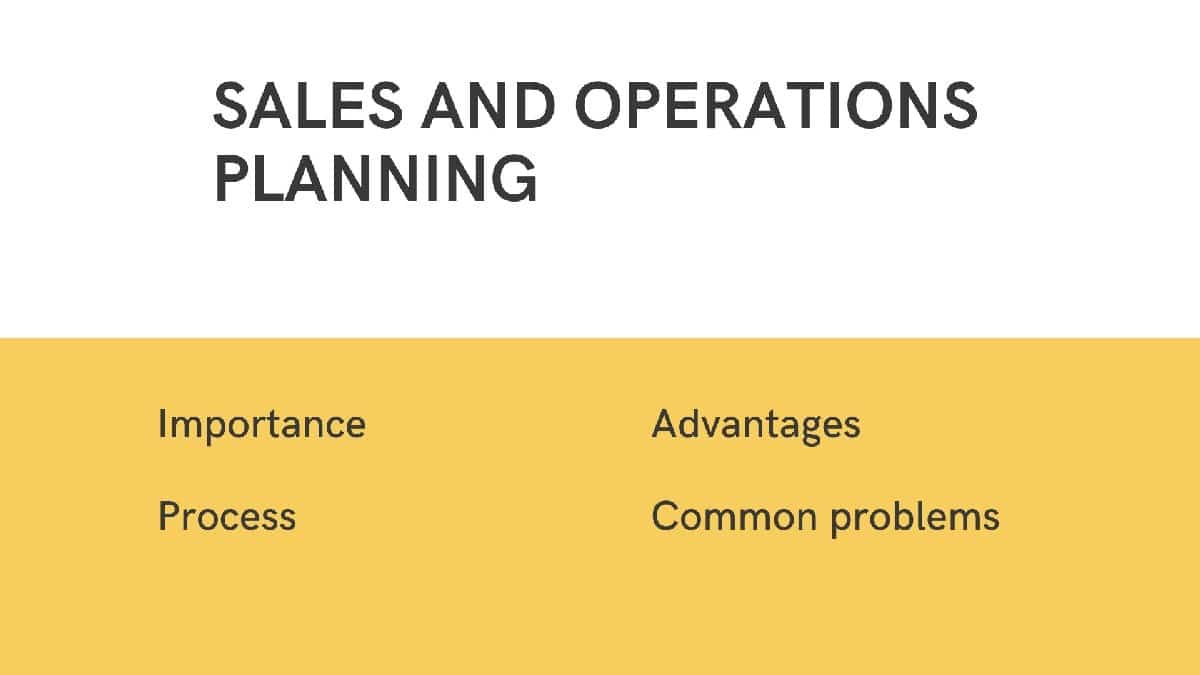
Sales And Operations Planning (S&OP) - Meaning and Importance | Marketing91
Sales And Operations Planning (S&OP) – Meaning and Importance
May 6, 2020 By Hitesh Bhasin Tagged With: Sales
Sales and operations planning is a process which helps in managing the demand and supply of manufacturer by collaborating the sales and operations department to create a single production plan.
It is also referred to as aggregate planning, and executive-level management meets regularly to review the projections for demand and supply and financial impact, which results because of it. Sales and operations planning is considered as the decision-making process, which ensures that the tactical plans and the business areas are in sync with the overall vision and mission of the company.
The primary advantage of having sales and operations and processes is that there is a single operating plan which identifies the company resources allocation, including employees, money, and time.
Table of Contents
Importance of sales and operations planning
There are some training activities like forecasting, which produces excellent results. But those results have a very narrow scope. For example, a statistical forecast will always depend on algorithms and history of the item to produce estimates. On the other hand, data such as profit projections and revenue, as well as marketing events, are usually not a part of statistical forecasting. This is why collaboration is not present in many of the original parts of the business.
On the contrary, sales and operations planning has the aim of getting a complete view of the plan by increasing the process of forecasting to marketing, sales, finance, etc. to have their inputs and adjustments together.
Advanced S&OP practices include POS or Point Of Sale and other related information to markets. Companies that look to acquire S&OP capacities can find them in many of the advanced supply chain planning software.
Sales and Operations Planning Process
Many steps are carried out in the sales and operations planning process, usually during monthly meetings. The numbers and names of all the steps differ in various companies depending on the industries, but the following are in common
1. Data collection:
Data collection involves the collection of all available forecasts and information. The estimates from the sales team, the forecasts from the market research team, and the forecast depending on the previous year sales are taken into consideration.
Along with the forecast, other data such as inventory available, the sales numbers for previous years, the market growth, and the expected projections are used in data collection.
2. Demand Planning
Demand planning is defined as the process which is used for analyzing, forecasting and influencing the demand. The sales and operations planning process involve the planning of demand in such a way that all the inventory is prepared with the organization.
The demand is managed according to the available forecasts and market intelligence. It is an essential step to plan the demand and let the manufacturing team know about the expected numbers. They can schedule their inventory accordingly.
3. Production planning
Once the demand is planned, the next step is to prepare the production. The production team, with the help of the operation planning process team, comes to know about the expected demand.
They need to arrange their inventory accordingly and maintain the production schedules so that the demand is fulfilled in time. The distribution capacity is also checked, and the possible constraints are determined. Once everything is in place, proper production planning can be formed.
There are three approaches which are used for production planning which are as follows:
Level production planning
When the cost of changing the production level is prohibitive, then level production planning is used. In these cases, the cost of holding inventory is also very less. For example, in the case of the oil industry was done with the help of level production planning the production, the production rate remains constant, and the differences between sales forecasting and production is absorbed by inventory.
Chase Production planning
This is precisely the opposite of level production planning. In chase production planning, the production is changed at every time interval of the plan so that it can match the sales forecast for that particular interval.
With the help of this approach, the production is always chasing the demand. Because of this, it is named as chase production planning. The method is used for companies that cannot hold the inventory. It is costly to do so otherwise.
Mixed Production Planning
This type of production planning takes part in both the types of production planning that is level and chase plans. There will be varieties in inventory levels in production that will produce the best production plan.
4. Reconciliation
After the demand planning and production, planning is prepared, both of the plans are aligned to ensure they meet the financial requirements of the company. If any changes are suggested by the finance team to comply with the financial terms, they are then checked with the company objectives.
Advertisement report
5. Executive meeting
The executive meeting then takes place after all the data collection, demand planning, production planning, and reconciliation between all the plans are done so that they can review and revisit the plan one more time.
The executive meetings also takes place so that the decision of board members and the long-term goals of the organization, if any, can be discussed, and the sales and operations and processes can be assigned with that accordingly. Changes, if any suggested by the executive team, have to be reworked before the final version is resubmitted for approval.
Tactical Planning in Sales and Operation planning Process
Strategic planning is the one that takes into consideration the plans of the organization, and tactical planning, on the other hand, looks at the business plan of the company over the coming year.
The overall strategy of the company is taken into consideration while planning tactically, which are also found in the strategic plan. Sales and operation planning are aimed at helping many companies develop tactical plans which are developed and aligned by many business areas.
Usually, there are two approaches which are used in sales and operations planning which are as follows:
1. Top-down planning
Top-down planning is considered as the most straightforward approach for sales and operations planning. There is a single sales forecast in the case of top-down planning, which drives the complete planning process.
Advertisement report
There are many products and services from which the estimate is derived, which requires similar resources. For example, many finished products. With the help of top-down planning, the management will be able to create a tactical plan which will be based on the complete forecast and divide the available resources across the finished goods in the plan.
2. Bottom-up planning
The bottom-up approach is used by many organizations that do not have a stable manufacturing schedule and the type or the number of finished goods every month. In these cases, the sales forecast is also not very useful for resource planning.
The management needs to have the calculation of resources for every product and then mix the resources to get a complete overview of the resource requirements.
Common problems in Sales and Operations Planning
Since Sales and operation planning is a Cross-functional process, it is difficult to assign the commercial purposes of the marketing and sales department with the supply chain’s operational processes.
Following are few of the standard and severe problems associated with sales and operations planning:
1. Alignment of Metrics
Organizational functions are usually not aligned by definition. There is always conflict over the metrics and incentives of business leaders. Hence without changing the metrics to be overarching across multiple functions; it is challenging for business leaders to align with the help of cross-functional processes
2. Supply chain complexity
Many people do not understand the features of the supply chain of their organization. Many executive teams and the leaders struggle to understand the interconnected non-linear relationship of the supply chain metrics.
That is why there is always conflict over the changing priorities. The supply chain has to be part of an operating strategy so that it can help improvements which most companies can only think about.
3. Organizational Misalignment
There is a big rift between the sales and operations teams of every organization. The leader of the smart profit center will usually take this problem head-on. He will have a list with the help of finance to drive the alignment between the product mix shifts and marketing strategies on inventory and cost positions.
4. Lack of Organizational Balance
The percentage of people who feel that the processes are well balanced between the operations team and the needs of the commercial side is very less. When sales and operations processes are balanced, the company can manufacture at minimal cost with a meager inventory.
Advertisement report
However, the process requires crystal clear communication of the alignment of metrics of organization and operating strategy.
5. Focus on Execution
Planning is a crucial part of the organizational strategy, but it is fruitless without proper execution. There is only 11 percent of companies that effectively link the sales and operations planning process and take it to implementation.
Many companies do not have synchronization between planning and execution, and this is essential to drive the performance of the sales and operations planning process, which will improve the business results.
Advantages of Sales and Operations planning
- Apart from improving the forecasting accuracy, there are many advantages of sales and operations planning, like cutting the inventory costs, which will enhance the working capital of the company. It can also increase the market share and revenue by improving the effectiveness of marketing initiatives and new products launched in the market.
- Sales and operation planning also improves delivery time rate, which will lead to improved customer satisfaction and the possible benefits which will arise from it like higher sales.
- It will also provide better visibility into marketing, sales, finance, and operations data.
- Sales and operation planning software will automate the process, which can reduce the planning cycle. It will reduce the labor costs and improve the productivity of the employees since they will be relieved of manual work. This will involve preparing forecasts and collaborating in one single plan.









